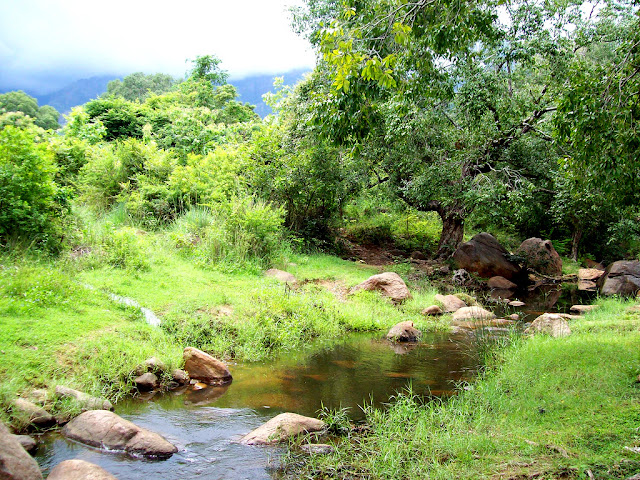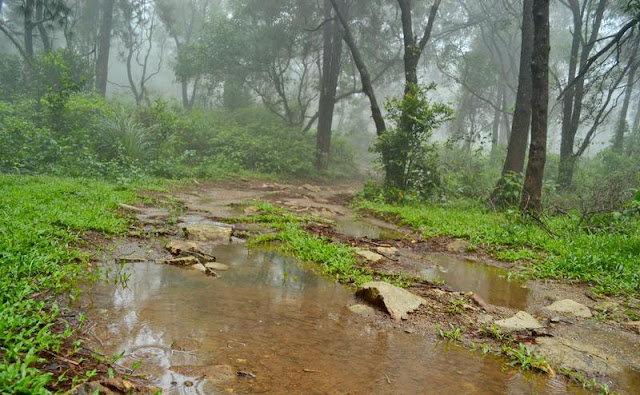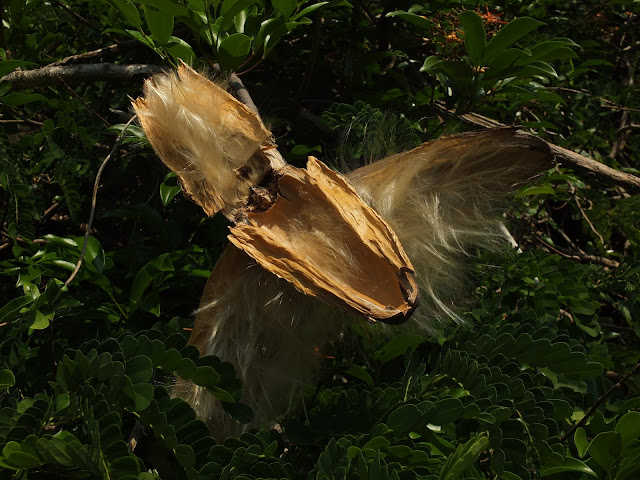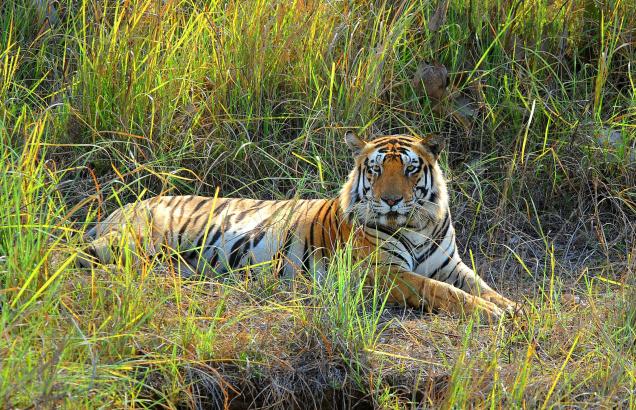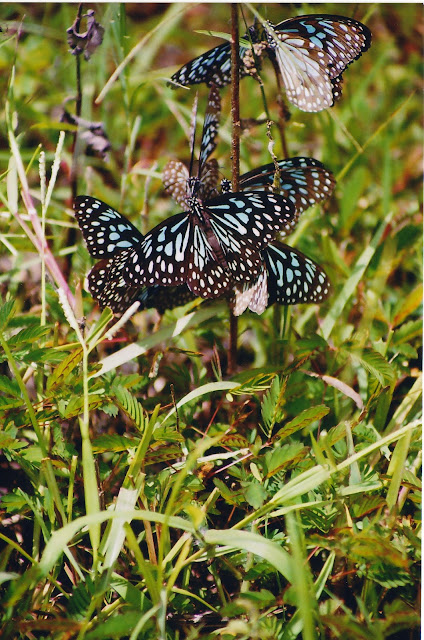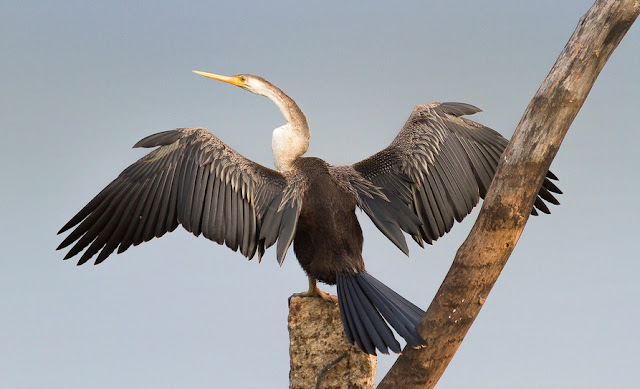Kalakkad Mundanthurai Tiger Reserve, Thirunelveli
Kalakkad Mundanthurai Tiger Reserve (KMTR)
located in the Southern Western Ghats in Tirunelveli District and Kanyakumari District in the South
Indian state of Tamilnadu, is the second-largest protected area in Tamilnadu
State (behind only Sathyamangalam Wildlife Sanctuary in Erode). Covering nearly 900 square kilometers, the combined
area of the Kalakad Sanctuary and the Mundanthurai Wildlife Sanctuary
is a treasure trove for wildlife enthusiasts and photographers. Extremely
rich in biodiversity, one can spot Mundanthurai wildlife in all its surrounding
beauty.
The
dense, dark forest cover is thrilling in its mystery with the promise of a
surprise at every corner. It is the 17th declared Tiger Reserve in
the country. Kalakad Mundanthurai Tiger Reserve has been classified as a
Type-1 Tiger Conservation Unit (TCU) representing tropical moist evergreen
forests in the world. Nestled between Kerala and Tamilnadu, the Agastya
Mala Hill Range forms the core area
of the Wildlife Sanctuary and is one of the five named biodiversity
and endemism centers in India. It is
also an UNESCO World Heritage Site.
Unique
in its climate and vegetation in such as different parts of the sanctuary
receive different amounts of rainfall, Mundanthurai is also a great place to
connect with nature. There are trails for trekking and one can do so at these
designated places after seeking permission from the forest and wildlife
authorities. Apart from endemic flora and fauna, avian life thrives in these
forests. A trust has been working with the locals to educate and provide them
with alternative sources for fuel and creating awareness about the value of the
biodiversity of the sanctuary delicate and the need to protect it.
History
The
Kalakkad Mundanthurai Tiger Reserve was created in 1988 by combining Kalakad Wildlife Sanctuary (251 km²) and Mundanthurai
Wildlife Sanctuary (567 km²), both established in 1962. Notification of
77 km² of parts of Veerapuli and Kilamalai Reserve Forests in
adjacent Kanyakumari district, added to the reserve in April 1996. A
400 km2 (150 sq. mi) core area of this reserve has been
proposed as a national park.
Geography
Located
between 8° 25’ and 8° 53’ N latitude and 77° 10’ and 77° 35’ E longitude,
Mundanthurai has a unique and different forest cover, with different parts of
the forest receiving different amounts of rainfall. The lower forests receive
an average annual rainfall of less than 1,000 mm while the upper forest gets
more than 4,000 mm rainfall each year. The upper reaches of the forest is
mainly tropical wet evergreen while the lower is dry deciduous. The average
temperature in the summer is 44 degrees C while in winters it is a pleasant 24
degrees C. Monsoons arrive later here than the rest of the country. The western
half of the sanctuary receives the lashings of the southwest monsoons while the
eastern part receives the gentler northeast monsoons.
KMTR forms
the catchment area for 14 rivers and streams. Among these rivers and
streams, Tambraparani, Ramanadi, Karayar, Servalar, Manimuthar, Pachayar, Kodaiyar, Kadana Nathi and Kallar form the
backbone of the irrigation network and drinking water for the people of Tirunelveli, Tuticorin and part of Kanyakumari District. Seven major dams – Karaiyar, Lower Dam, Servalar,
Manimuthar, Ramanadi, Kadana Nathi and Kodaiyar – owe their existence to these
rivers. The reserve spans a range of 40 to 1,800 m in elevation. Agasthiyamala (1681 m) is in the core zone of the reserve.
Conservation
KMTR
forms part of the inter-state (Kerala and Tamil Nadu) Agasthiyamala Biosphere
Reserve. This part of Agastya
Mala hills in the core of KMTR is considered one of the
five centers of biodiversity and endemism in India by the International Union for
Conservation of Nature (IUCN).
The Western Ghats, Agasthiyamala Sub-Cluster, including all of Kalakkad
Mundanthurai Tiger Reserve, is an UNESCO World Heritage Site. The Ashoka Trust for Research in Ecology and the
Environment (ATREE) has developed and implemented a conservation
intervention program in KMTR to decrease local villager’s dependency on the
forests for fuel to and build community awareness about the value of
biodiversity in the area.
"Agasthya", the KMTR newsletter, includes updates on research
projects and staff activities at KMTR. The contents of the first issue included:
"A Sanctuary for Cycas circinalis," "Tiger Almost,"
"Round in Agasthiyamala in Fourteen Days," "Corridors - It is
Just Not for the Four Legged Furry Creatures," "Behavior and Movement
of Nilgiri Langur in the Upper Kodaiyar Range – KMTR," "Canopy News," "Agasthya Village Commons and
Backyards to Meet the Biomass Requirements: An Experiment with Panchayat
Raj and Women Collectives," "Bi-Lingual Field Guide Test Run,"
"Snippets from the Field," "Cullenia exarillata: A Keystone Species for Birds?"
and "Tea, Tiger and Oranges".
Tigers
are also protected in Tamil Nadu at Muthumalai National Park, Indira Gandhi National Park and
Wildlife Sanctuary, Mukurthi National Park and Sathyamangalam Wildlife
Sanctuary.
Flora
& Fauna
KMTR has
at least 150 endemic plants, 33 fish, 37 amphibians, 81 reptiles, 273
birds and 77 mammal species.
Flora
The
vegetation types ranges from forests of tropical West Coast Tropical Wet Ever
Green forest to Tropical Dry Mixed Deciduous Forest and Thorn Forest makes it
one of the richest biodiversity areas in the world. The reserve boasts
flat land, rolling parkland, open grassland, swamps, valleys and Nullas. Important
species include evolutionarily significant Sarcandra, a vessel less Angiosperm,
Paphiopedulum, druryi, a rare orchid and Nageia wallichiana a broad leaved and
only conifer tree of south India.
Other
important tree species include Hopea parviflora, Hopea utilis, Calophylum
elatum, Cullenia exarillata, Artocarpus hirsute, Syzygium sp., Cinnamomum
zeylanicum, macaranga roxburghii, Mesua ferrea, Gluta travancorica, Canarium
strictum, Veteria malabarica, Myristica species, Vitex altissima, Dysoxylm
malabaricum, Anacolosa densiflora, Elaeodendron glacum, Eleocarpus
tuberculatus, Alstonia scholaris, Mangifera indica, Decussocarpus wallichianus,
Podocarpus latifolia, Eugenia species, Garcinia cambogia,Xanthophyllum
flavescens, Felicium decipiens, Mallotus phillippinensis, Litsea species,
Dalbergia latifolia, Kingiodendron pinnatum, Wrightia tinctoria, Chloroxylon
suietenia, Pterocarpus marsupium, Anogeissus latifolia, Careya arborea, Emblica
officinalis, Dalbergia paniculata, Albizia lebeck, Tectona grandis, Ficus spp.,
Hardwickia binata, Terminalia chebula, etc.
Fauna
Kalakad-Mundanthurai
is one of the best tiger reserves of India. Recent Census by Project Tiger
produced the following wildlife counts: Tiger 73, leopard 79, jungle
cat 1 755, wild dog 1 718, gaur 232, Sambar 1 302, chital 1 966, Nilgiri
tahr 8 780, wild
pig 187, mouse
deer 172, sloth
bear123, lion-tailed macaque 37, bonnet
macaque 61, Nilgiri
Langur 61, common
Langur 61, slender
Loris 61, giant
squirrel 61, and crocodile 61. Habitat use by the grey
jungle fowl (Gallus sonneratii)
at Mundanthurai plateau, Tamil Nadu, was investigated from December 1987 to
March 1988.
Besides
Tiger Panthera Tigris, it has Leopard P. pardus as the
major predator, and ungulates such as Sambar Cervus unicolor, Spotted
deer Axis axis, Barking Deer Muntiacus muntjak and Mouse
Deer Moschiola meminna. Asian Elephant Elephas maximus,
Gaur Bos frontalis, Nilgiri Langur Trachypithecus johni, Bonnet
Macaque Macaca radiata, Lion tailed Macaque M. silenus, Slender
Loris Loris tardigradus, Sloth Bear Melursus ursinus, Indian Giant
Squirrel Ratufa indica, are also reported from this IBA. Rusty-spotted
Cat Prionailurus rubiginosus and Nilgiri Martin Martes
gwatkinsi are two uncommon species reported from this area.
Among
the reptiles, King Cobra Ophiophagus Hannah, Indian Rock Python Python molurus,
Monitor Lizard Varanus bengalensis and Draco or Gliding Lizard Draco dussumieri are
some of the interesting species found in this IBA. The Western Ghats EBA has
about 120 species of amphibians, of which 90 are restricted to rainforests.
Thirty two species have been recorded from this site, of which 25 are endemic
of the Western Ghats. The Black Narrow-mouth
Frog Melanobatrachus indicus was rediscovered after 100 years in
Kakachi. Dasia halianus, an arboreal skink, reported earlier only from Sri
Lanka, was discovered by Johnsingh and Joshua (1989) from the threatened
gallery forest of River Tambiraparani.
This
site has rich reptilian diversity, and a total of 81 species has been
identified. Some species of biological and ecological importance include Calotes
andamanensis, Cochin Forest Cane Turtle Geoemyda silvatica, Anaimalai
Gecko Hemidactylus anamallensis and Indian Kangaroo Lizard Otocryptis
beddomii. KMTR is also famous for many rare and endemic hill stream fish of the
Western Ghats. Recently, Arunachalam and Johnson (2002) have described a new
species of Puntius from the streams of River Tamiraparani,
named Puntius kannikattiensis.
Fishes:
Glossogobius
giuris, Mastacembelus armatus, Channa striatus, Channa orientalis, Etroplus
maculatus, Etroplus suratensis, Oreichormis mossambica (Tilapia mossambica), Macrones
vittatus (Macrone vittatus), Ompak bimaculatus (callichrous bimaculates),
Heteropneutes fossilis (saccobranchus fossilis), Xenentodon cancila (Belone
cancila), Aplocheilus lineatus (Haplochilus rubrostigma), H.lineatus synonym of
Aplocheilus lineatus, Bhavania australis (Homaloptera brucei), Gara
lissorhynchus (Discognathus modestus), Cyprinus carpio communis, Labeo
funbriatus, L.calbasu, Cirrhina mrigala, Catla catla, Puntius sarana sarana
(Barbus sarana), Gonoproktopterus dubius (B.dubius), B.carnaticus, Tor khudree
(B.malabaricus), Puntius amphibius (B.amphibius), Puntius arulius (B.arulius),
Puntius filamentosus (B.machecola), Punties sophore (B.stigma), Parluciosma
daniconius (Rasbora daniconius), Danio aequipinnatus, Salmostoma sardinella ( Chela
untrahi), Nemacheilus pulchellus and Anguilla bengalensis are the fish varieties dound in this reserve.
Amphibians:
Endemic Species:
Bufo
beddomii, Bufo microtympanum, Indirana beddomi, Indirana brachytarsus, Indirana
diplostictus, Indirana leptodactylus, Limnonectes keralensis, Melanobatrachus
indicus, Micrixalus fuscus, Micrixalus suxicola, Nyctbatrachus deccanensis,
Nyctibatrachus aliceae, Nyctibatrachus beddomii, Nyctibatrachus major,
Nyctibatrachus vasanthi, Philautus charius, Philautus glandulosus, Philautus
pulcherimus, Philautus variabilis, Ramanella Montana, Rana aurantiaca, Rana
curtipes, Rana malabarica, Rana temporalis, Rhacophorus calcadensis,
Rhacophorus malabaricus, Uraeotyphlus malabaaricus.
Non – Endemic
Species:
Bufo
melanostictus, Bufo fergusoni, Euphlyctis cynophlictis, Hoplobatrachus
tigerinus, Ichthyophis longicephalus, Ichthyophis sp-1, Ichthyophis sp-2,
Limnonectes keralensis, Limnonectes limnocharis, Micrixalus opisthorhodus,
Micrixalus silvaticus, Microhyla ornata1 Microhyla rubra, Phillatus beddomii,
Phillatus nasutus, Polypedates maculatus,sEERana brachytarsus, Tomopterna
rolande, Uraeotyphlus oxyurus.
Reptiles:
Endemic
Species:
Ahaetulla
dispar, Ahaetulla perrotetti, Amphiesma beddomii, Brachipodium rhodogaster,
Calliophis melanurus nigroscenes, Calotes adamanensis, Calotes ellioti, Calotes
grandiquamis, Calotes nemoricola, Calotes rouxii, Calotes versicolor, Cnemaspis
beddomei, Cnemaspsis indica, Cnemaspis ornatus, Dendrelaphis granddoculis,
Draco dussumieri, Geoemyda silvatica, Hemidactylus anamallensis, Hemidactylus
maculatus, Liopeltis calamaria, Lycodon travancoricus, Mabuya gansi,
Melanochelys trijuga, Melanophodium punctatum, Oligodon brevicaudus, Otocryptis
beddomii, Psammophilus dorsalis, Python molurus, Ristella beddomii, Scincella
travancoricus, Teretrurus gramineus, Trimeresurus malabaricus, Trimeresurus
strigatus, Uropeeltis arcticeps, Uropeltis ellioti, Uropeltis liura, Uropeltis
ocellatus, Varanus bengalensis.
Non
endemic Species:
Ahaetulla
dispar, Ahaetulla nasutus, Ahaetulla pulverulenta, Amphiesma stolata, Atretium
schistosum, Boiga ceylonensis, Boiga forsteni, Boiga trigonatus, Bungarus
caeruleus, Calotes calotes, Chamaeleo zeylanicus, Chrysopelea ornate, Cnemaspis
littoralis, Coluber mucosus, Crocodiles palustris,Cytodactylus dakanensis,
Dasia halianus, Dendrelaphis tristis, Elaphe helena, Eryx conicus, Geochelone
elegans, Hemidactylus brookii, Hemidactylus frenatus, Hemidactylus
leschenaulti, Hemidactylus triedrus, Heosemys silvatica, Hypnale hypnale,
Lycodon aulicus, Lygosoma punctatus, Mabuya beddomei, Mabuya carinata, Mabuya
macularicus, Macropisthodon plumbicolor, Naja naja, Oligodon ornensis, Oligodon
taeniolatus, Ophiophagus hannah, Ophisops leschenaultii, Psammophilius
blanfordanus, Ptyas conicus, Ptyas mucous, Ramphotyphlops braminus, Riopa
punctata, Sitana ponticeriana, Sphenomorphus dussumieri, Trimeresurus
macrolepis, Typolops braminsee, Vipera russelii, Xenochropis piscator.
Mammals:
The
flagship species are Tiger, Asian Elephant and Lion tailed Macaque. The
co-predators of Tiger include wild-dog or Indian Dhole and Leopard. Other
species are: Madras hedgehog, Days' shrew, Grey musk shrew, Hill (mountain)
shrew, Pygmy shrew, Fulvous fruit bat, Indian flying fox, Lesser dog-faced
fruit bat, Short-nosed fruit bat, Lesser mouse-tailed bat, Black-bearded tomb
bat, Pouch-bearing bat, Greater false vampire, Lesser false vampire, Rufous
horseshoe bat, Blyth's horseshoe bat, Lesser woolly horseshoe bat, Dusky
leaf-nosed bat, Fulvous leaf-nosed bat, Schneider's leaf-nosed bat, Evening
bat, Painted bat, Slender loris, Bonnet macaque, Lion-tailed macaque, Common Langur,
Nilgiri Langur, Indian jackal, Bengal fox (from outside PA), Dhole or Asiatic
wild dog, Sloth bear, Nilgiri marten, Common otter, Smooth coated otter,
Oriental small clawed otter, Small Indian civet, Common palm civet, Jerdon's
(brown) pawn civet, Common Indian mongoose, Brown mongoose, Ruddy mongoose,
Stripe-necked mongoose, Leopard cat, Jungle cat, Rusty-spotted cat, Leopard,
Tiger, Asian elephant, Wild boar, Indian spotted chevrotain or mouse deer,
Barking deer, Chital, Sambar, Gaur, Nilgiri tahr, Indian pangolin, Common palm
squirrel, Dusky striped squirrel, Jungle striped squirrel, Indian giant
squirrel, Indian giant flying squirrel, Travancore flying squirrel, Malabar
spiny dormouse, Indian gerbil, Indian bush rat, Soft-furred field rat or metad,
White-bellied wood rat, Indian field mouse, Bonhote's mouse, House mouse, Spiny
field mouse, Indian long-tailed tree mouse, Lesser bandicoot rat, large
bandicoot rat, Indian porcupine and hare.
Avi Fauna
Kalakad-Mundanthurai
is one of the most important sites for the Western Ghats endemics, due to good
forest cover in most parts of this Tiger Reserve. Nearly 160 birds,
representing 93 genera and 40 families, have been listed. Of these, 77 are
residents, 41 winter visitors, 30 altitudinal migrants and two summer visitors
(Joshua and Johnsingh 1988). However, Johnsingh (2001) has mentioned that Katti
et al. (unpublished) identified 273 species of birds in and around KMTR.
The
globally threatened White-bellied
Shortwing Brachypteryx major is found in high elevation
rainforests, particularly in Neterikal area. The Oriental Bay Owl Phodilus
badius, an uncommon species has been recorded from Sengaltheri (Johnsingh
2001). Kodayar area could support a good population of Broad-tailed
Grass-Warbler or Grassbird Schoenicola platyura. The site lies in the
Western Ghats Endemic Bird Area (EBA), where Stattersfield et al. (1998) have
listed 16 restricted range species.
Except
for the Nilgiri Laughingthrush Garrulax cachinnans, which is confined
to the Nilgiris (Ali and Ripley 1987, Grimmett et al. 1998), all the remaining
15 restricted range species of this EBA are found here. This is one of the few
sites in the Western Ghats where so many restricted range species are found.
This also reflects the diversity and quality of habitats available in this IBA.
This site also has eight Near Threatened species. Given the extensive habitats,
the population of Great Pied Hornbill Buceros bicornisand Greater
Grey-headed Fish-eagle Ichthyophaga ichthyaetus could be
significant, although both were considered rare by Joshua and Johnsingh (1988).
Bird Species found in this reserve are Grey
Francolin, Rain Quail, Jungle Bush Quail, Small Buttonquail, Yellow-legged
Button quail, Barred Button quail, Red Spurfowl, Painted Spurfowl, Grey
Junglefowl, Indian Peafowl, Bar-headed Goose, Lesser Whistling-duck, Cotton
Pygmy-goose, Spot-billed Duck, Northern Pintail, Eurasian Wryneck, Speckled
Piculet, Rufous Woodpecker, White-bellied Woodpecker, Brown-capped Pygmy,
Woodpecker, Lesser Yellownape, Streak-throated Woodpecker, Common Flameback,
Black-rumped Flameback, Greater Flameback, Brown-headed Barbet Crimson-fronted
Barbet, Coppersmith Barbet, Malabar Grey Hornbill, Great Hornbill, Common
Hoopoe, Malabar Trogon, Indian Roller, Common Kingfisher, Oriental Dwarf
Kingfisher, Stork-billed Kingfisher, White-throated Kingfisher, Black-capped
Kingfisher, Pied Kingfisher, Green Bee-eater, Blue-tailed Bee-eater,
Chestnut-headed Bee-eater, Pied Cuckoo, Chestnut-winged Cuckoo Large Hawk
Cuckoo, Indian Cuckoo, Lesser Cuckoo, Grey-bellied Cuckoo, Drongo Cuckoo, Asian
Koel, Blue-faced Malkoha, Sirkeer Malkoha, Greater Coucal, Vernal Hanging
Parrot, Rose-ringed Parakeet, Plum-headed Parakeet, Malabar Parakeet, Indian
Swiftlet,White-rumped Needletail, Asian Palm Swift, House Swift, Fork-tailed
Swift, Alpine Swift, Crested Treeswift, Oriental Bay Owl, Oriental Scops Owl,
Eurasian Eagle Owl, Spot-bellied Eagle Owl, Brown Fish Owl, Brown Wood Owl,
Jungle Owlet, Spotted Owlet, Brown Hawk Owl, Sri Lanka Frogmouth, Grey
Nightjar, Large-tailed Nightjar, Indian Nightjar, Rock Pigeon, Nilgiri Wood
Pigeon, Mountain Imperial Pigeon, Laughing Dove, Spotted Dove, Eurasian
Collared Dove, Emerald Dove, Pompadour Green Pigeon, Slaty-legged Crake,
White-breasted Waterhen, Purple Swamphen, Common Moorhen, Common Coot, Snipe,
Green Sandpiper, Eurasian Thick-Knee, Black-winged Stilt, Little Ringed Plover,
Yellow-wattled Lapwing, Red-wattled Lapwing, River Tern, Whiskered Tern,
Osprey, Jerdon's Baza, Black Baza, Black-shouldered Kite, Black Kite, Brahminy
Kite, Grey-headed Fish Eagle, Egyptian Vulture, Red-headed Vulture, Crested
Serpent Eagle, Pallid Harrier, Crested Goshawk, Shikra, Besra,Eurasian
Sparrowhawk, Oriental Honey-buzzard, Common Buzzard, Long-legged Buzzard, Tawny
Eagle, Booted Eagle, Rufous-bellied Eagle, Changeable Hawk Eagle, Kestrel,
Eurasian Hobby, Laggar Falcon, Little Grebe, Darter, Little Cormorant, Little
Egret, Great Egret, Intermediate Egret, Cattle Egret, Indian Pond Heron, Grey
Heron, Little Heron, Black-crowned Night Heron, Malayan Night Heron, Black
Bittern, Glossy Ibis, Black-headed Ibis, Black Ibis, Eurasian Spoonbill,
Spot-billed Pelican, Painted Stork, Asian Openbill, Indian Pitta, Asian Fairy
Bluebird, Blue-winged Leafbird, Brown Shrike, Bay-backed Shrike, Rufous
Treepie, White-bellied Treepie, House Crow, Large-billed Crow, Ashy
Woodswallow, Eurasian Golden Oriole, Black-hooded Oriole, Large Cuckooshrike,
Black headed Cuckooshrike, Small Minivet, Scarlet Minivet, Bar-winged
Flycatchershrike, Black Drongo, Ashy Drongo, White-bellied Drongo, Bronzed
Drongo, Greater Racket-tailed Drongo, Black-naped Monarch, Asian
Paradise-Flycatcher, Common Iora, Large Woodshrike, Common Woodshrike, Blue
Rock Thrush, Malabar Whistling Thrush, Pied Thrush, Orange-headed Thrush, Scaly
Thrush, Eurasian Blackbird, White-bellied Shortwing, Asian Brown Flycatcher,
Rusty-tailed Flycatcher, Brown-breasted Flycatcher, Red-throated Flycatcher,
Black-and-orange Flycatcher, Verditer Flycatcher, Nilgiri Flycatcher,
White-bellied Blue Flycatcher, Blue-throated Flycatcher, Tickell's Blue
Flycatcher, Grey-headed Canary Flycatcher, Indian Blue Robin, Oriental Magpie
Robin, Indian Robin, Black Redstrat, Pied Bushchat, Chestnut-tailed Starling,
Brahminy Starling, Common Myna, Jungle Myna, Hill Myna, Velvet-fronted
Nuthatch, Black-lored Tit, Eurasian Crag Martin, Dusky Crag Martin, Barn
Swallow, Pacific Swallow, Wire-tailed Swallow, Red-tailed Swallow, Northern
House Martin, Grey-headed Bulbul, Black-crested Bulbul, Red-whiskered Bulbul,
Red-vented Bulbul, White-browed Bulbul, Yellow-browed Bulbul, Black Bulbul,
Grey-breasted Prinia, Jungle Prinia, Ashy Prinia, Oriental White-eye,
Grosshopper Warbler, Blyth's Reed Warbler, Thick-billed Warbler, Broad-tailed
Grassbird, Orphean Warbler, Common Tailorbird, Greenish Warbler, Large-billed
Leaf Warbler, Western Crowned Warbler, Wynaad Laughingthrush, Grey-breasted
Laughing-thrush, Puff-throated Babbler, Indian Scimitar Babbler, Tawny-bellied
Babbler, Dark-fronted Babbler, Yellow-eyed Babbler, Rufous Babbler, Jungle
Babbler, Yellow-billed Babbler, Brown-cheeked Fulvetta, Singing Bushlark,
Indian Bushlark, Ashy-crowned Sparrow Lark, Eurasian Skylrak, Thick-billed
Flowerpecker, Purple-rumped Sunbird, Crimson-backed Sunbird, Purple Sunbird,
Loten's Sunbird, Little Spiderhunter, House Sparrow, Forest Wagtail, White
Wagtail, White-browed Wagtail, Yellow Wagtail, Grey Wagtail, Nilgiri Pipit,
Paddyfield Pipit, Baya Weaver, Indian Silverbill, White-rumped Munia,
Black-throated Munia, Scaly-breasted Munia, Black-headed Munia and Common
Rosefinch.
Medicinal
Plant Conservation Area
MPCA- Mundanthurai:
In
Mundanthurai Range, Medicinal plants were planted over 150 ha. Hibiscus,
Emblica, Pomagranade, Tulsi, Vilvam and other medicinal plants were raised.
Besides, from 2001-02, upto 2005-06 nearly 36000 plants have been distributed
free of cost to the public. Moreover about 4000 seedlings have been planted in
Agathiar Kani Settlement, Servalar Settlement, Mundanthurai Forest staff
quarters, Kani school buildings and Servalar Government Hospital building.
MPCA- Nambi Koil:
Nambi
Koil nursery is established in ½ an acre area. Emblica, Neem, Vettiver, Naval
are some of the medicinal plants raised there. From 2003-04, 2005-06 nearly
20,000 seedlings were raised and distributed locally free of cost. Further 4000
seedlings have been distributed as a part of raising medicinal plants through
kitchen garden in the nearby villages.
Settlements
The
Kalakkad Mundanthurai Tiger Reserve has a large number of employees of the
Electricity Board and Public Works Department who stay in three colonies and
work at Karayar, Upper Dam, Servalar and Upper Kodaiyar reservoirs within the
reserve. Bombay Burmah Trading Corporation has a 33.88 km² land
in the core area of the reserve leased from Singampatty Zamin valid until 2028.
The
Company has tea and coffee plantations and three factories, and employs about
10,000 workers in the reserve. There are several small estates and five Kani Tribal habitations, consisting of about 102
families. About 145 hamlets situated within 5 km of the 110 km
eastern boundary of the reserve are inhabited by 100,000 people. There are
about 50,000 cattle grazing out of these fringe villages, with a small number
of cattle owned by the tea estate workers and residents of the electricity
board colonies.
Biodiversity
Western
Ghats is one of the 25 global hotspots and one of the 3 mega centers of
endemism in India. Agasthiyamala which forms part of KMTR is one of the 5
centers of plant diversity and endemism in India (IUCN). Among all the Tiger
Reserves in the country, KMTR is probably the richest from the biodiversity
point of view. This is also described as ‘Super-hotspot’ of Biodiversity. The
floral diversity includes 2,254 Angiosperms which includes 448 endemic species,
58 Red- listed species, 601 Medicinal species, 90 species of wild relatives of
the cultivated plants.
There
are 3 Gymnosperms and 156 Pteridophytes. The faunal diversity includes 47
species of fish, 47 species of amphibians, 89 species of reptiles, 337 species
of Birds and 79 species of Mammals. The entire spectrum of biodiversity of KMTR
has been documented in book titled “Biodiversity of Kalakad Mundanthurai Tiger
Reserve” by R. Annamalai and published by Tamil Nadu Forest Department.
‘Current science’ has brought out a special issue on KMTR (Volume 18, No.3, 10th
February 2001).
Waterfalls
There
are 3 important waterfalls which attract lakhs of tourists every year. They are
Agasthiyar falls and Banatheertham falls adjoining Karayar Dam in Mundanthurai
Range and Manimuthar falls in Ambasamudram Range.
Religious
Tourism
Sorimuthu
Iyyanarkoil in Mundanthurai Range, Nambi Koil in Thirukkurungudi Range and
Golaknath Temple in Kadayam Range are important tourist destinations.
Trekking
Trekking
is another important activity in this Tiger Reserve. Following are the trekking
routes available in this reserve;
·
Thalayanai – 6 KM. –
Karungal Kasam/ Woodhouse and Dormitary 7.5 KM. Mudul
·
Iruppan W. House – 7 KM –
Mulakalasam – 15 KM – Kakachi
·
(Log house) – 14 KM Upper
Kodaiyar – Sengaltheri (R. House, W. house, I. Shed) – 14 KM - K.Range – K.R.F.
·
Netterikal (No halt) – 8
KM – Thirukkurungudi Range K.R.F.
·
Narakad (No halt) – 19 KM-
Nambikoil (W.House)
·
Kannikatti FRH – 21 KM. –
Pandipatti
·
Mundanthurai – (18th KM.
Vadamadi RH) – 24 KM Valaiyar
·
Karaiyar – 4 KM - Sevalar
(E.B.) Rest House
·
Kalakad Range – K.R.F. –
Sengaltheri R.H. Dormitory – 10 KM- Mulakalasam
Best Time
to Visit
The best
time to visit is between October and January. The sanctuary is open to the
public from October to the summer months, but given that it becomes
uncomfortably warm, one should consider visiting the sanctuary before summer
sets in.
Tips
·
Carry travel essentials
(Soaps, towel, mosquito repellent, flashlight etc.).
·
There is no cellular
connectivity within the reserve except in a few select locations.
·
Do not venture anyplace
without informing the Range officer or his subordinates first.
·
Collect information
pamphlets from the Ambasamudram office.
Getting
Around
It is
best to have your own transport when staying within the reserve as most of the
places are far flung. Even if driving in your own vehicle, consult the range
officer for any restrictions. Some places can only be approached with the
forest guards acting as guides.
Eating
& Shopping
Make
sure you have stocked up before departing from Ambasamudram (the last major
town). There are no shops within the forest perimeter except for some small
general stores selling basic stuff.
Accommodation
Facilities
The
Forest Department’s Rest House has two suites and dormitory style
accommodation. Suites are reserved for visiting forest officials. One can call
ahead and reserve accommodation at the Rest House. Ambasamudram has a few
mid-budget bed and breakfast hotels. There are many hotels and resorts around
Tirunelveli.
Forest
Rest Houses are available in Mundanthurai, Kalakad (Shengaltheri) and Kuthiravetti.
Send email to ddambai@yahoo.co.in for reservations. Call DD (Deputy Director
Office) – 04634250594. Local Guide will be arranged by the Range officer.
Contact
Chief
Conservator of Forests & Field Director
Project
Tiger, Kalakad Mundanthurai Tiger Sanctuary,
NGO
Colony, Thirunelveli – 627007
Phone: +91 – 462 – 2552663
Email: tvl-kmtrpt@sancharnet.in
Web: www.kmtr.org
Connectivity
Kalakad
Mundanthurai Tiger is located at about 12 Kms from Papanasam, 23 Kms from Ambasamudram,
58 Kms from Kalakkad, 70 Kms from Thirukkurungudi, 25 Kms from Sivasailam, 46
Kms from Tenkasi, 50 Kms from Manjolai, 68 Kms from Thirunelveli, 230 Kms from
Madurai, 115 Kms from Thoothukudi and 160 Kms from Thiruvananthapuram.
By Road:
This
reserve can be accessed by road from Thirukkurungudi, Kalakad, Papanasam,
Ambasamudram and Sivasailam. Buses are plying to reach Mundanthurai and Upper
Kodayar and these roads pass through the Tiger Reserve. Regular bus services
are available Tirunelveli which takes a little over than an hour.
By Train:
Nearest
Railway Station is located at Ambasamudram.
By Air:
Nearest
Airport is located at Madurai, Thoothukudi and Thiruvananthapuram.









